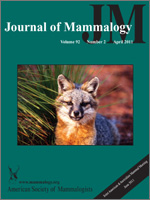Maternal attendance patterns in free-ranging wildlife can provide insight into basic biology, foraging behavior, and population dynamics. We collected detailed visual observations of attendance patterns by adult lactating Steller sea lions (Eumetopias jubatus) from 2005 to 2007 on 6 major rookeries in the Russian Far East, including those with an increasing population trend (Sea of Okhotsk), severely depleted populations that were recovering (Kuril Islands), or those that were stable (Commander Islands). Individually identifiable females were observed during the postpartum period, with special attention paid to presence and absence during the day and to departure and arrival times. Within Russia females on several Kuril Islands rookeries exhibited extremely short foraging trip durations (median 6.5–8.0 h) and spent higher proportions of time on the rookery (75–82%), whereas females in the Sea of Okhotsk population had the longest trips (median 19.8 h) and spent the least amount of time on the rookery (60%). Most indices of attendance pattern were more favorable (longer peripartum period, higher proportion of time spent on rookery, shorter trips, and longer visits) than those reported in Alaska and much more so than those in California during El Niño years, where the proportion of time spent on the rookery was nearly half that in Russia. Females >6 years of age had shorter trips and longer visit durations than the youngest females (4–5 years), and older mothers exhibited significantly longer periods of nursing before taking their 1st trip, suggesting greater physical condition for older females. Although trip durations remained constant throughout the season, visit durations shortened significantly as the pups aged, suggesting that increasing nutritional demands of pups are met by more frequent, rather than longer, trips. No apparent relationships between attendance patterns and population status were observed; however, many of the differences in attendance patterns throughout the range of the Steller sea lion could be related to local variation in bathymetry and diet patterns.
How to translate text using browser tools
15 April 2011
Environmental and biological factors influencing maternal attendance patterns of Steller sea lions (Eumetopias jubatus) in Russia
Vladimir Burkanov,
Eliezer Gurarie,
Alexey Altukhov,
Evgeny Mamaev,
Peter Permyakov,
Alexey Trukhin,
Jason Waite,
Tom Gelatt
ACCESS THE FULL ARTICLE

Journal of Mammalogy
Vol. 92 • No. 2
April 2011
Vol. 92 • No. 2
April 2011
ASIAN POPULATION
Commander Islands
Eumetopias jubatus
foraging behavior
Kuril Islands
maternal attendance patterns
postpartum nursing period




